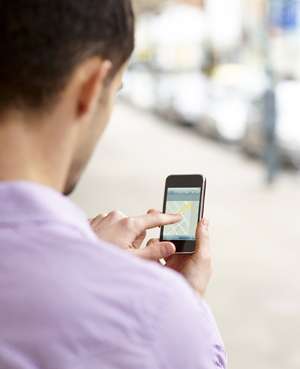A system based on machine-learning simplifies the way a mobile electronic device determines its location using wireless hotspots. Credit: altrendo images/Stockbyte/Thinkstock
Many mobile-phone applications (apps) use spatial positioning technology to present their user with location-specific information such as directions to nearby amenities. By simultaneously predicting the location of the mobile-user and the data access points, or hotspots, improved accuracy of positioning is now available, thanks to an international research team including Sinno Jialin Pan from the A*STAR Institute for Infocomm Research. Software developers expect that such improvements will enable a whole new class of apps that can react to small changes in position.
Traditionally, device position was determined by the Global Positioning System (GPS) that uses satellites to triangulate approximate location, but its accuracy falters when the mobile device is indoors. An alternative approach is to use the 'received signal strength' (RSS) from local transmitters. Attenuation of radio waves by walls can limit accuracy; and, it is difficult to predict signals in complex, obstacle-filled environments.
Software developers have tried to circumvent these problems by using so-called 'learning-based techniques' that identify correlations between RSS values and access-point placement. Such systems do not necessarily require prior knowledge of the hotspot locations; rather they 'learn' from data collected on a mobile device. This also has drawbacks: the amount of data can be large, making calibration time consuming. Changes in the environment can also outdate the calibration.
Pan and his co-workers reduced this calibration effort in an experimental demonstration of a protocol that calculates both the positions of the device and the access points simultaneously—a process they call colocalization. "Integrating the two location-estimation tasks into a unified mathematical model means that we can fully exploit the correlations between mobile-device and hotspot position," explains Pan.
First, the researchers trained a learning-based system with the signal-strength values received from access points at selected places in the area of interest. They used this information to calibrate a probabilistic 'location-estimation' system. Then, they approximated the location from the learned model using signal strength samples received in real-time from the access points.
Experimental trials showed that this approach not only required less calibration, but it was more accurate than other state-of-the-art systems. "We next want to apply the method to a larger-scale environment," says Pan. "We also want to find ways to make use of the estimated locations to provide more useful information, such as location-based advertising." As this technique could help robots navigate by themselves, it may also have important implications for the burgeoning field of robotics.
More information: Pan, J. J., Pan, S. J., Yin, J., Ni, L. M. & Yang, Q. Tracking mobile users in wireless networks via semi-supervised colocalization. IEEE Transactions on Pattern Analysis and Machine Intelligence 34, 587–600 (2012). ieeexplore.ieee.org/xpl/articl … ontentType=Journals+%26+Magazines&sortType%3Dasc_p_Sequence%26filter%3DAND%28p_IS_Number%3A6136512%29





















